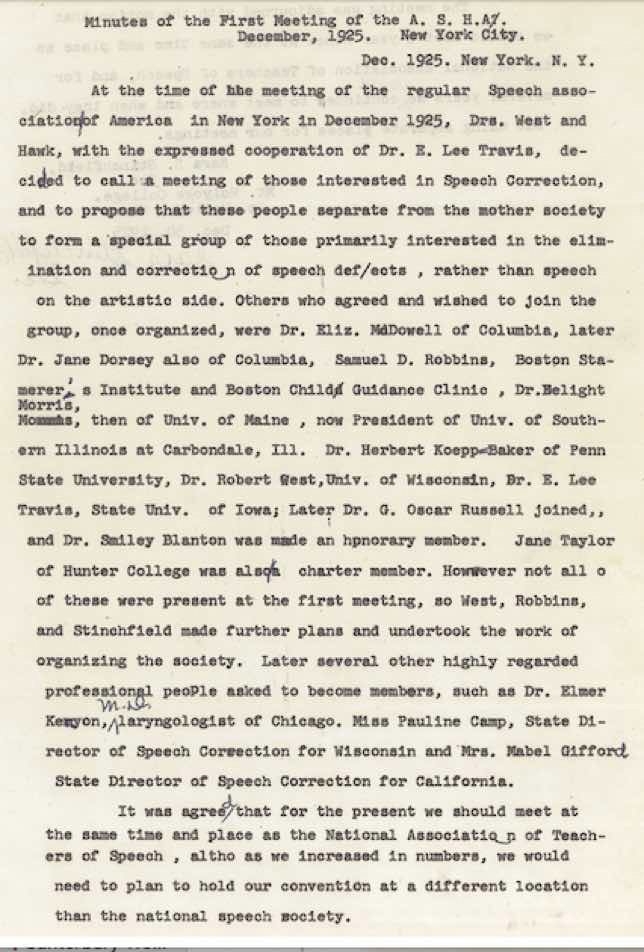Part 1 Introduction: Preparing the ground
Today’s researchers and practitioners in the field of speech pathology and audiology in the US are coming up on a centennial birthday. Nearly one hundred years ago, in 1925, ASHA was officially created. Those in this field who are are aware of their professions’ history identify early 1925 as the year when our profession began. Some say it began at the dining room table of Robert West, in Iowa City, when the group attending declared themselves independent of their mother organization, the American Speech Association (Paden, 1970; Van Riper, 1989; Malone, 1999; Robertson, 2019; Speech Easy, 2021; ASHA, 2021; ASHA archives, 2021). Others point to the time, later that same year, when another group, overlapping the first, met at a Speech Association of America convention in New York and declared themselves independent from that parent organization. ASHA’s current website offers us a record of that later meeting in December 1925 (ASHA, Archives, 2021).

But, like live plants, professions have long gestation periods. Their histories are complex ones, and include preparing the ground, seeding, flowering, and pollination. They grow gradually and cumulatively out of activities carried out by individuals. They also emerge from informal gatherings of people with common interests, goals, and vision. And they take shape when people collaborate in more formal ways as they carry out their research and clinical activities. Finally, professions are influenced by social movements and technical advances. That more complex history of our professional origins needs exploring.
This essay makes such an effort. It aims to trace various 19th century beginnings that led to the recognized emergence of the speech pathology profession in America early in the 20th century. Some of that earlier history happened in Central Europe. Research and clinical advances in Germany and Austria during this period preceded and developed alongside that important meeting of friends and colleagues that took place in a dining room in Iowa in 1925 and the meeting room at the Speech Association of America Convention.
Another thread leading to ASHA’s founding came from the elocution movement. That history is described in another section of this website. Elocutionists practicing in America focused primarily on improving speech and voice performance, such as that which took place during lecturing, acting, singing, and oral reading. One wing of the elocution movement included professionals who provided lessons to improve speech of those with speech disorders. Alexander Graham Bell exemplified the elocution teachers of this period. He opened a school in 1872 in Boston Massachusetts for improving articulation, stuttering, and the speech of the deaf.
The following literature review, focusing on the Central European influences on early American speech pathology, is part of a larger history that was divided into six periods:
- History of the ancients: 3000 BC to 500 AD
- Middle ages: 400 to 1500 AD
- Early modern period: 1500 to 1700 AD
- Enlightenment: 1700 to 1800 AD
- 19th century 1800 to 1900 AD
- 20th century 1900 to 2000 AD
This piece of history fits in-between the 19th and 20th century, just before and after ASHA was born. This in-between history pays tribute to scholars and clinicians in Europe showing their influence on our founding fathers and mothers. It is divided into three sections:
Planting the seeds. This covers a period to time, in the middle of the 19th century, when our European ancestors developed theoretical, descriptive, and scientific practices for studying the brain, tracing children’s development, and designing psychotherapies for adults with psychological problems. These ancestors, mostly physicians, also carried out speech-therapy practices that they wrote and taught about.
The first flowerings. Later in the 19th and early 20 century, two hubs of clinical and research practice related to speech disorders formed, one in Berlin, under the influence of Hermann Gutzmann, and a second in Vienna, under the influence of Emil Froeschels. In these hubs were individuals who engaged in research, carried out clinical activities, and mentored others who traveled from all over the world to learn about this new specialty.
Pollination. Some 50 years later, after the second world war, the Central European influences began to take root in America. Some of those same European mentors emigrated to America in the 1930s and after, continuing to influence their American colleagues. These ancestors and their American colleagues provided a necessary knowledge base that formed the needed justification for the establishment of an independent profession.
